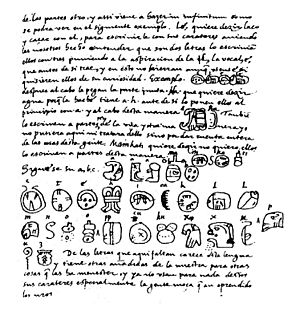Relación de las cosas de Yucatán facts for kids
Relación de las cosas de Yucatán (which means "Account of the Matters of Yucatán") is a very important book written by Diego de Landa around 1566. He wrote it shortly after returning to Spain from Yucatán. This book helps us understand a lot about the ancient Maya people and their culture.
In his book, de Landa listed many Mayan words and phrases. He also included some Maya hieroglyphs. These hieroglyphs are sometimes called the de Landa alphabet. They were super important for people in modern times trying to figure out how to read the ancient Maya writing. The book also describes Maya religion and the general culture of the Maya people. De Landa wrote it with help from local Maya leaders. At the end of a long list of Spanish words with Maya translations, there's a famous Maya phrase that means "I do not want to." The original book is lost, but many copies still exist today.
Contents
About the Book
This book is a key source for learning about the Maya civilization just after the Spanish arrived. It gives us a look into their daily lives, beliefs, and how they wrote things down.
Why is it Important?
The Relación de las cosas de Yucatán is very important for several reasons. It contains the "de Landa alphabet," which was a big step in understanding Maya hieroglyphs. Before this, no one knew how to read them. This book helped experts finally start to unlock the secrets of Maya writing. It also describes many parts of Maya culture, like their customs, history, and religious practices.
What Happened to the Maya Books?
Diego de Landa wrote about how the Maya people kept their history and knowledge in special books. He said these books used unique characters and signs. Sadly, he also wrote about a difficult event: "These people also used special characters or letters. They recorded their histories and knowledge in their books. We found many books with such letters. Because we believed they contained superstitions, we burned them all. This made the Maya people very sad and upset."
This act led to the loss of many valuable Maya texts. It was a big blow to their culture and history. However, de Landa's own book, despite this, became a crucial tool for future generations to learn about what was lost.
Later Editions and Translations
The first time this book was published was in 1864. Charles Etienne Brasseur de Boubourg published it in French. The original title was very long!
Later, the book was translated into English. William E. Gates translated it in 1937, calling it Yucatan Before and After the Conquest: The Maya. Another important translation was done by Alfred Tozzer from the Peabody Museum of Archaeology and Ethnology in 1941. These translations made de Landa's work available to many more people around the world.
See also
 In Spanish: Relación de las cosas de Yucatán para niños
In Spanish: Relación de las cosas de Yucatán para niños


